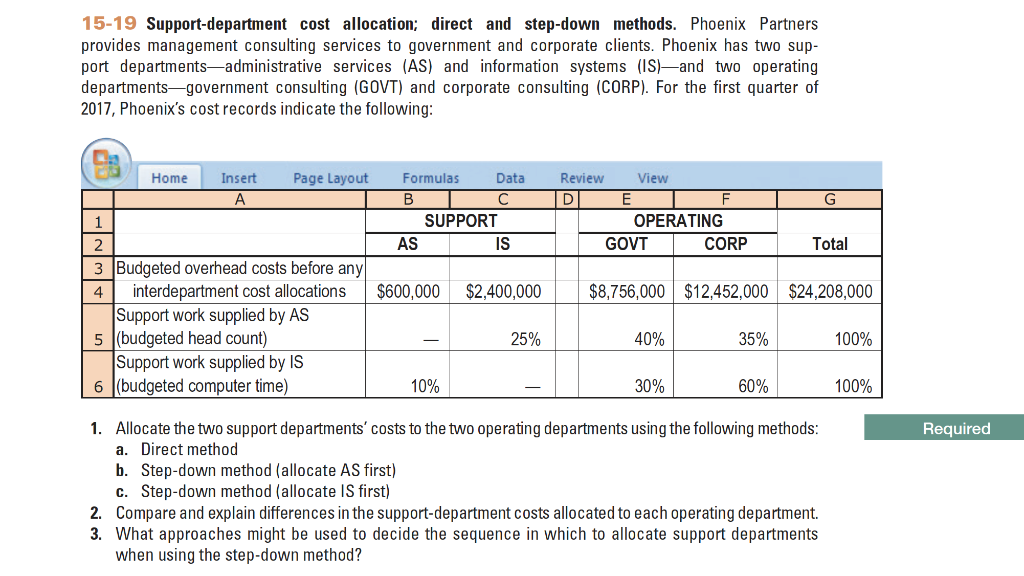
Some examples of service departments include purchasing, receiving and storage, engineering, power, maintenance, packing, shipping, inventory control,inspection and quality control. Service department costs must be assigned (applied, allocated, or traced) to the inventory for product costing purposes. This method allocates the costs of some service departments to other service departments, but once a service department’s costs have been allocated, no subsequent irs announces e 2020 costs are allocated back to it. The sequence in which the service departments are allocated usually effects the ultimate allocation of costs to the production departments, in that some production departments gain and some lose when the sequence is changed. Hence, production department managers usually have preferences over the sequence. A company ranks its service departments by the percentage of its costs that are consumed by other service departments.
What are common mistakes people make when allocating costs?
For example, the power department uses some power and the maintenance department requires somemaintenance. Reciprocal services refer to situations where two or more service departments provide services to each other. For example, the power departmentprovides electric power to the maintenance department and the maintenance department provides repair and maintenance to the power department. Theserelationships affect the choice of allocation methods, as well as the accuracy of the first stage cost allocations. There are no service departments left, so the legal department can only allocate costs to operating departments. Many companies in all sectors of the economy, and not-for-profit and governmental organizations as well, allocate service department costs to “production” or user departments, and ultimately to the products and services that they provide.
Which activity is most important to you during retirement?
It is the most complex method but provides the most accurate representation of cost relationships. Proper cost allocation is a cornerstone of accurate financial accounting and management. Allocating costs from cost centers, such as Administration, where costs are incurred, to profit centers, such as Sales, where profit is generated, is essential for understanding and optimizing business profitability.
- 2) Solve the system of equations for the service departments [1] simultaneously.
- Following this decision rule, the joint costs arenot relevant because they will not be different regardless of the decision to sell at the split-off point or to process the products beyond this point.
- For example, if your company produces two products, A and B (and each product has its own direct labor cost), you would first need to determine how many units of Product A are produced for every unit of Product B sold.
- Activity-based costing is like dividing that restaurant bill according to who ate what.
Ask a Financial Professional Any Question

Therefore, system designers must also carefully consider the motivational, or behavioral aspects of alternative cost allocationmethods. At no point in the step allocation process is there any reciprocal allocation of service costs back to the service departments that have already allocated their costs out to other departments. Because of this lack of reciprocal allocations, the step allocation method is not the most theoretically correct. Departmental rates based on machine hours would provide accurate product costs.b.
Describe several types of supporting logic for cost allocations methods including the concepts of “cause and effect”, “ability to bear” and “fairness andequity”. Briefly discuss when each concept appears to be appropriate. The term “joint products” refers to a group of products that are produced simultaneously by a common process. A group of joint products is inseparable until the productsreach a certain point where they are divided or split into separate products. This point is frequently referred to as the split-off point.
Luckily, modern planning software can transform cost allocation from a time-consuming, Excel spreadsheet-based headache into a precise, streamlined process. There are many reasons companies may use each of these allocation methods. Here is another explanation of this concept if you would like further clarification. For example, suppose you’re using a full absorption costing (FAC) system and another department within your company is using a direct labor cost system.
The Assembly Department manager is likely to complain that neither of the allocations in Exhibit 6-11 is equitable. He or she might logically argue that the dual rate method illustratedabove assigns the Power Department’s idle capacity costs to the Assembly Department. These idle capacity costs will in turn be allocated to the AssemblyDepartment’s products. Using a single budgeted rate, rather than either a single actual rate or dual rate (Exhibit 6-11) will normalize the service costsallocations, provide more timely costing and aid in evaluating the service departments. Conceptually, this is the same logical argument discussed inChapter 4 under the heading of reasons for using a predetermined overhead rate. Departmental overhead rate allocations are illustrated in the top section of Exhibit 6-15.
The first step involves developing equations to reflect the relationships between the service departments and the producingdepartments, i.e., equation form [2] presented above. After these equations are developed, they are used to allocate the service department costs directly tothe producing departments in the second step. Although this is the simplest method, it is also the least accurate method. Cost allocation allows you to determine where costs can be reduced and provides accurate reporting on company financials based on its relative performance. Allocating indirect expenses is also important for decision-making purposes. With this information, you can determine which areas of your business need improvement and how changes in production will affect overall profitability.
For instance, if the sales team generates 60% of company revenue, they might bear 60% of certain overhead costs. Direct costs have a clear connection to specific products or services—like the materials and labor needed to make a product. Meanwhile, indirect costs support the whole business but can’t be tied to particular products.
OnEntrepreneur is the go-to source for entrepreneurs looking to get ahead. Our online magazine offers practical, actionable advice to help startups succeed across key areas like business strategy, marketing, technology, leadership, management and more. Sign up for our regularly updated newsletter to receive our latest articles and insights directly in your inbox. It is relatively straightforward to understand and implement compared to more complex cost allocation techniques. Instead of discovering issues in historical reports, you can address them as they emerge.

